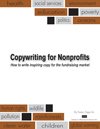Donors are influenced by their experiences as consumers. And as consumers they have evolved and continue to raise the bar.
For example: They are less responsive to direct mail that has NO personalization. The exact same letter sent to 76,000 or to 1.8 million people doesn’t work at all like it used to. Today people want to be recognized as individuals and not a mere number among the masses.
One Size Hurts All
Taking the “one size fits all” approach and using the same letter or email to your entire list hurts everyone.
It starts with the prospect or donor receiving your letter. They might be miffed or disappointed by a generic approach. Or they may simply have a ho-hum reaction. The result is that fewer people give, and they give smaller gifts. Prospects are hurt because they weren’t given the chance to personally connect with your mission. They weren’t given the chance to add fulfillment to their lives because the letter was generic and uninspiring.
Your nonprofit is hurt because you don’t raise as much revenue. And the beneficiaries of your mission are hurt because they don’t receive as much help. One size hurts all.
Data to the Rescue
Segmenting your file and using data to tailor communications to individuals is the way to personalize and raise response. Now data management is not my area of expertise; so I won’t even attempt to talk about how you get the data.
But I do know I can write a far more compelling direct mail letter or email when I’ve got data on my recipients – the people receiving the message.
It’s a superior letter when I can focus on writing to a major donor and show what their gift of $1,000 will do. It’s a superior letter when I talk to a mid-level donor about what they’ve made possible in the past, how we appreciate their 4 years of devotion to the cause, and show what their $150 gift will do.
Response goes up (i.e., the number of gifts received and/or average gift size) and everyone is helped by using data to send personalized, customized letters or emails.
Winning Example
Rarely am I able to share response data on the work I do for clients. But I can share this example from the April 2011 issue of Direct Marketing to illustrate the difference tailored messages make:
Capital Hospice – located in Washington DC – wanted to reduce mailing costs and still meet its fundraising goals.
Their agency (DirectMail.com) used analytics to generate a file with 400 distinct data points such as household income and donation base. Using data and a segmented file they created multiple appeals to each of the segments.
Results:
– Mailed about 100,000 fewer pieces and saved nearly $150,000 in mailing costs; cut costs about 25%.
– Capital Hospice met its fundraising goal of $1 million in revenue
– Increased the average gift amount by 20.37% to $72.22 from $60
It may seem like you’re saving money by sending the exact same letter to everyone … but the odds are it’s actually costing you dearly. One size hurts all. Invest in getting the data you need so your copywriter can write an appeal that gets better response.

{ 3 trackbacks }
{ 4 comments… read them below or add one }
Wow Karen, as a direct mail professional, I can’t thank you enough for sharing this! I launch direct mail campaigns for clients every day, and I also wanted to emphasize how true this is. People are more responsive to appeals that are tailored to them. The sad truth is that this is so much easier to accomplish than most nonprofits realize-this even applies for small nonprofits.
I’m not a data expert either, but I recognize the critical importance of maintaining an accurate nonprofit database. Based on blog comments and feedback from readers, I decided to interview a few nonprofit software vendors and asked them to answer the same group of questions; I then added their answers as a series of blog posts. The bottom line is that nonprofits that start with an organized database have a much easier time executing personalized campaigns.
Blase,
I appreciate your kind words and endorsement on the importance of this issue.
From what I’ve been told and read, there’s a high ROI on creating and maintaining a quality database. Even if the nonprofit didn’t get off to the best start with their database, investing to overhaul and get on solid ground is some of the wisest spending they can do – so I’m told.
Terrific piece, Karen! And I completely agree.
I think for many of us in smaller shops, the data is the trick. On the one hand, we can actually grasp most of our list – learn about them individually over time. On the other, we don’t often have the means or expertise to find the right database solution – one that not only tracks gifts, but holds all those little pieces of information that will be so useful in managing relationships (including mail).
In any case, it’s so true – the more personal the appeal, the better the response.
Thanks for writing this!
Mary,
I appreciate your generous praise – most kind.
And I recognize that smaller shops have some additional resource challenges. It’s not easy. Each person wears several hats. That alone makes it difficult to have time for researching vendors. Perhaps I can save you a bit of time.
Although I can’t speak from personal experience (smile), I have heard positive comments from small nonprofits that use one of these two vendors: Click&Pledge and DonorPerfect. They’re both geared especially for the smaller nonprofits.
Oh, and if you have a question you want answered here in my blog, please let me know. I’d be glad to help you.